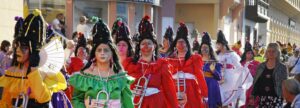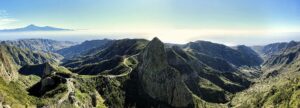historical overview
Approx. 3.000 BC Chr .: The Canary Islands are settled from North Africa, and the Guanche Kingdom emerges.
From 1.000 BC. Chr .: Myth of antiquity: The islands are believed to be the sunken Atlantis (Plato), the Elysian realms (Homer), the gardens of the Hesperides (Herodotus) or the Happy Islands (Virgil).
By 1.000 AD: Roman and Arab sailors visit the "islands at the end of the world" without settling there.
1344: The Spaniard Luis de la Cerda is from Pope Clement VI. appointed King of the Canary Islands. The title is irrelevant as the islands do not seem to have any riches.
1402-1405: The Norman Jean de Béthencourt conquered Lanzarote, Fuerteventura, El Hierro and La Gomera for the Spanish crown on behalf of the Spanish king.
1500-1700: Spaniards, especially Andalusians, and Portuguese colonized the islands and began growing wine and sugar cane.
1657: The English are also interested in the Canary Islands as a stopover on the way overseas. Naval Battle of Santa Cruz (Tenerife) during the Anglo-Spanish War. Defeat Admiral Blake's fleet.
1706: English Navy attacked Santa Cruz (Tenerife) during the War of the Spanish Succession. Victory over the ships of the English Admiral Jennings.
1797: The English admiral Horatio Nelson is defeated in an attempt to conquer Santa Cruz and loses his right arm.
1852: Declared a free trade zone by the Spanish government, the Canary Islands are experiencing an economic boom, from which the port cities of Santa Cruz de Tenerife and Las Palmas de Gran Canaria in particular benefit.
1912: The Canaries get the right to local self-government.
1927: Two provinces arise: Santa Cruz de Tenerife (west) and Las Palmas de Gran Canaria (east).
1936: General Francisco Franco, posted to Tenerife, begins the Spanish Civil War (1936-39) from Morocco. He ruled Spain dictatorially until his death in 1975.
Around 1950: Timid beginning of tourism. In 1957, charter flights began. The closure of the Suez Canal by the Egyptian President Abdel Nasser revitalized the shipping routes on the African coast and thus the ports of Santa Cruz and Las Palmas.
1975: After the death of Franco and the end of the dictatorship, the Canary Islands are striving for more independence from the Spanish government.
1982: After the autonomy laws come into force, the islands will become an autonomous region of Spain.
1985: The Canary Islands receive a special status within the European Community, ie they enjoy advantages in terms of customs and tax regulations.
Early references
The Canary Islands have always been shrouded in legend. In ancient times they were considered the lands behind the Pillars of Hercules, as the Strait of Gibraltar was called at that time. Many classical poets suspected paradise, the Elysian realms or the garden of the Hesperides here.
Scientists still argue about where the first indigenous people of La Gomera came from. There is a lot of room for hypotheses. There are still numerous legends surrounding the islands of the blissful. The first written record of the Canaries comes from Pliny, who mentions an expedition to the islands sent by the Mauritanian King Juba II in the 1st century AD. According to tradition, the participants of the expedition brought home a couple of huge dogs, which supposedly later gave the islands their name: Canaries, from canis, the Latin word for dog. Today there are still some specimens of a bloodhound-like, primitive Canarian breed with a wild and impressive appearance on the archipelago.
According to another theory, the island name comes from the Berber word Canarii, the name for a North African tribe. Until the conquest of the island by the Europeans in the 15th century, the island was inhabited by a people who probably had North African roots, the Guanches.
It is believed that as early as the 5th millennium BC The first settlers could have landed on La Gomera. It is still unclear today whether they are North African Berber tribes or members of the megalithic culture from the western Mediterranean. It is also not clear whether a specific emigration took place.
What is certain is that around 1100 to 800 BC The Phoenicians, coming from today's Cadiz, traveled the Atlantic as daring seafarers and probably discovered all the Canary Islands. Because here the Phoenicians found the coveted dye plant, the orchilla lichen, and brought it to their homeland. The purple substances obtained from it became their most important and most sought-after commodity.
It is assumed that the indigenous people of La Gomera had no contact with Africa or their neighboring islands.
The way of life of the indigenous people was almost Stone Age, albeit with signs of a higher level of culture related to religion and handicrafts. Most of them lived as farmers and shepherds who also subsisted on fishing. The peace-loving natives still dressed in furs. Despite their simple way of life, they buried their dead carefully. In special cases they even mummified them with very effective techniques and had a special sense of grave decorations. They worked clay like clay without using a turntable. Their lances, called añepas, ended in sharp points made of raw volcanic rock. Everything indicates that they did not operate any shipping. The social structure of the old Canary Islands based on equality is considered to be highly developed.
The natural religion of the indigenous peoples, in which cosmic and earthly elements (stars, rain, plants, animals, mountains etc.) as well as the belief in good and bad influenced, was the most important pillar of their culture. Social, political and economic life followed the religious aspects. The places of worship on the table mountain La Fortaleza and on the highest mountain on the island, the Garajonay, still bear witness to the religious culture of the Gomerian indigenous people.
Many ancient writers and also some modern authors were or are of the opinion that the Canary Islands represent the highest remains of the submerged continent of Atlantis. The Guanches are therefore the last descendants of the Atlantids. The descendants of the mountain dwellers would have had to adapt to their new habitat very soon after the downfall, now becoming island dwellers. There are a few arguments in favor of this thesis: the lack of knowledge of seafaring, their lack of communication between the islands and the extraordinary body size of some Guanches.
The Spanish Conquest
The geographical location of La Gomera, as well as the other Canary Islands, was known early on. Already in the years 85 to 160 AD it was determined exactly by the mathematician and geographer Ptolemy. The ancient knowledge was not lost, but the islands of eternal spring in Europe fell into oblivion. The islands of the blessed were not remembered for centuries until the end of the 12th century when seafarers and traders set out to open up new markets. Improved shipping technology enabled them to get here faster from now on. The islands were invaded, the population partly enslaved, raw materials were made their own.
The conquest of the Canary Islands by Spain began in 1402 under the leader Jean de Béthencourt in the name of Henry III. of Castile with attacks on Lanzarote, Fuerteventura and El Hierro. Tenerife was the last island to be conquered, as the indigenous people there resisted fiercely until they were defeated in 1496.
The Spanish conquest of La Gomera began in 1404 after the Norman nobleman Jean de Bethencourt had already incorporated Lanzarote, Fuerteventura and El Hierro into the Spanish crown. The native Gomer population was divided into four tribal groups at this time. Bethencourt acted under the guise of Christian mission, but his interest was more economic. Bethencourt's attempt to take La Gomera failed because of the bitter resistance of the indigenous people. A later attack subdued two of the four tribes.
The Spanish administrators of the island changed several times until finally, from 1447, Hernan de Peraza, together with the beautiful Beatriz de Bobadilla, cruelly ruled La Gomera. The fortress tower Torre del Conde was built as a retreat for the rulers in San Sebastian.
The two non-subjugated tribes continued to oppose the regime and were only finally defeated in 1488 as a result of an ambush by Alonso Fernandez de Lugo, the conqueror of Tenerife and La Palmas.
After the conquest, many locals were sold as slaves on the Spanish mainland or relocated within the archipelago in order to prevent possible uprisings. Already in 1514 they were legally equated with the Spaniards. A feudal system was established that was maintained on La Palma until the 18th century.
Christoph Columbus
The island's capital, San Sebastian, is the starting point for Columbus' journey to the New World. La Gomera boasts as Isla Columbiana and emphasizes that America was consecrated with water from La Gomera. The sentence “Columbus set out from here” adorns the coat of arms of the capital, San Sebastian.
Cristobal Colon (Christopher Columbus) set out on his expedition to the west in the name of the Spanish crown. On August 12, 1492, his fleet was anchored on the coast of Gomera for the last time before crossing the Atlantic to load provisions and water. Many locals, it is also heard, were hired as sailors in his fleet and valiantly stood by his side in his discovery of America. It is still unclear how long Columbus stayed on the island of La Gomera.
It is said that his departure was delayed out of love for the beautiful island mistress Beatriz de Bobadilla. Hernan Peraza's widow, a beautiful and cruel rival of Queen Isabella of Castile, ruled La Gomera after the murder of her equally brutal husband in 1487. All that is historically documented is that Columbus stayed on the island in 1492 and during later voyages of discovery in 1493 and 1498. It has not been proven whether he knelt down in prayer in the Church of the Assumption of Mary, whether he actually had a passionate love affair with Beatriz de Bobadilla and whether the water from the well of the customs house in San Sebastian was used for the consecration of America.
The house in which he lived during his stay on Gomera is located on Calle de Medio and can be visited. Today it houses a gallery with changing exhibitions. On the main square of San Sebastian, where huge ficus trees provide shade, lies the old customs house, from whose well Columbus drew the water for the crossing. With this water, the Gomeros say, America was baptized.
The fountain can still be visited today. In September 1492, Columbus left the port of San Sebastian heading west and landed in the New World in October.
Since Columbus called the port of La Gomera on his voyage of discovery to America more than 500 years ago, the island has served many seafarers as a stopover on their overseas voyages.
The Modern Age
Sugar cane and wine were La Gomera's main exports up until the 16th century. In 1852 the Canary Islands were declared a free trade zone. After an economic crisis, new trends were set in the 19th century: the cochineal scale insect that lives on prickly pear cacti provided coveted and highly traded red dyes. But a short time later, with the invention of synthetic dyes, the costly production of cochineal collapsed again. Against the background of economic hardship, there was a wave of emigration at the end of the 19th century. Many Gomeros tried their luck in Cuba and Venezuela.
In the 20th century, the focus was first on growing tomatoes, and later on bananas.
When Franco died in 1975, King Juan Carlos campaigned for the introduction of democracy. For the first time, the Canarios had the chance to elect their own regional government. In 1982 the Canary Islands were granted autonomous status and were divided into the two provinces of Gran Canaria and Tenerife, with La Gomera belonging to the latter.
When Spain joined the European Community, the Canary Islands were granted a special status with sales guarantees for bananas, which expired in the mid-1990s.
Today the island government focuses on agriculture and fishing, but above all on sustainable tourism. The individual areas on La Gomera are supported by targeted funding programs.






